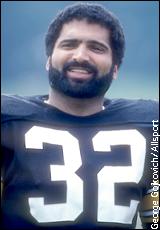
|
Friday, Jan. 8 8:11pm ET Two words say it all: 'Immaculate Reception' |
|||||||
|
From ESPN SportsCenter
No two words in NFL playoff history bring such a vivid picture to mind. No two words describe a turn of events more clearly. No two words tell a story as succinctly.
In case you were wondering, No. 3 on the list of ESPN's NFL Divisional Playoff Games as voted by ESPN.com users occurred in 1972 at Three Rivers Stadium. It involved the Oakland Raiders and Pittsburgh Steelers. And it was decided by a play that only those who were in the stadium truly witnessed.
Sure, Franco Harris caught the ball just as it was falling to the Three Rivers turf. And yes, the Steelers won 13-7. But exactly how Harris happened to be where he was, and how the ball found him all alone in the middle of the field, won't be found on film.
The pass from Terry Bradshaw to running back Frenchy Fuqua is captured clear enough. So is the vicious hit by Raiders' safety Jack Tatum that jars the ball loose and back toward the line of scrimmage. But that's when the highlight cuts to the end zone shot of Harris reaching down to pick the ball out of the air.
Where did he come from? The "Immaculate Reception" has captured the imagination of NFL fans across the country.
"When I see the film, that's like proof that it happened," Harris said. "But like, it still seems like a dream."
The game leading up to Harris' catch? It wasn't to bad either.
Scoreless at halftime, Roy Gerela's third-quarter field goal gave the Steelers a 3-0 lead.
Raiders head coach John Madden pulled flu-ridden Daryle Lamonica in favor of Ken Stabler in the third quarter and "The Snake" didn't fare much better. Late in the quarter, Stabler fumbled after a big hit. The Steelers capitalized with another Gerela field goal for a 6-0 lead.
But with 1:30 left in the game, Stabler turned a broken play into a 30-yard touchdown and the Raiders suddenly led for the first time, 7-6.
"We're winning the whole game, right?" Franco said. "I mean, tough defensive game. That game was one of the toughest defensive games I ever played in.
"And after 58½ minutes, it really takes something out of you. But, being the team that we were that year, no way we were going to give up."
The Steelers got the ball back at their own 20. But Bradshaw could only move Pittsburgh to its own 40 with under 30 seconds to play.
"I hate to say this, but you know, I went in there thinking, 'OK, well, this is probably the last play. And you know, this is the last play of the season,'" Harris said.
Steelers head coach Chuck Noll sent the play in with rookie running back Barry Pearson, who he hoped could slip free and pick up a first down. The play turned into the "Immaculate Reception."
Bradshaw never had time to see Pearson, instead the play broke down and Bradshaw was forced to scramble away from pressure. On the run, Bradshaw spotted Fuqua open -- but so did Tatum.
Bradshaw threw the ball down field. The ball and Tatum arrived at Fuqua at the same time.
"There was a collision," said Fuqua. "I got there, Tatum got there, there was a collision."
Now, in 1972, a pass could not rebound from one receiver to another without first touching a defensive player. That, of course, raised the question still debated today -- did Fuqua actually touch the ball?
"It's a part of my life now," Fuqua said. "I hear about it wherever I go. 'Did you touch it, Frenchy?'
"By God, it's the only secret I have in the world."
Whether or not Fuqua touched the ball, Harris caught it and raced down the sidelines for a game-winning touchdown.
"Nice to have the play the way it is, huh. No one knows all the details," Harris said. "I don't know about Frenchy's part. He doesn't know about my part. It makes it kind of interesting that way."
"I want to say the play was planned, but any way you look at it, it was immaculate," said Fuqua.
|
| Copyright 1995-98 ESPN/Starwave Partners d/b/a ESPN Internet Ventures. All rights reserved. Do not duplicate or redistribute in any form. ESPN.com Privacy Policy (Updated 01/08/98). Use of this site signifies your agreement to the Terms of Service (Updated 01/12/98). |

